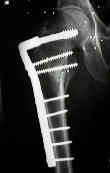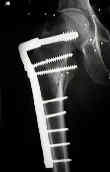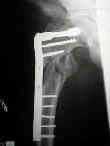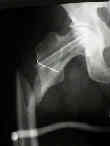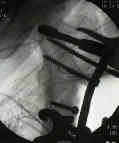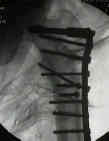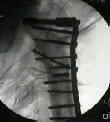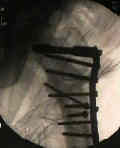- See: Bone Healing w/ Plates
- Discussion:
- useful in subtrochanteric frxs since it permits insertion of at least two cortical screws into proximal fragment (calcar);
- having multiple points of fixation above and below the fracture prevents varus or rotational migration;
- blade plate is useful in transverse or multiple large fragments that can be anatomically reduced to restore medial stability;
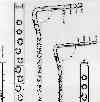

- PreOp Planning: (see operative checklist):
- determine if fracture fragments are amenable to lag screw fixation prior to plate application;
- this may convert a complex mult-part frx to a more simple 2 or 3 part frx;
- determine site of entry for the blade plate;
- consider need for bone grafting and prep appropriately;
- ask the anesthesiologist for absolute muscle relaxation (paralysis), and remember that much higher doses of paralytic are required to relax the larger muscles (gluteus maximus) as compared to the hand intrinsics (which are often used to determine if paralysis is present);
- determine if fracture fragments are amenable to lag screw fixation prior to plate application;
- this may convert a complex mult-part frx to a more simple 2 or 3 part frx;
- positioning:
- if the reduction looks challenging, then consider the lateral position over the fracture table;
- the lateral position allows free motion of the thigh and knee joint which is often required for anatomic reduction, and the lateral position facilitates posterior exposure of the femur (which is often necessary);
- if lesser troch is still attached to proximal fragment, psoas becomes deforming force causing flexion and external rotation of proximal fragment;
- 90 to 90 position aligns distal fragment;
- abduction of distal fragment may be needed to compensate for hip abductor force on the proximal frag;
- note that with lateral positioning, there may be some difficulty in judging the proper anteversion of the sliding screw, since the lateral view can only be accomplished with the thigh in the frog lateral position (full external rotation);
- if the subtrochanteric fracture has already be lag screwed together, then the thigh can be carefully placed in the frog lateral position, and the position of the guide wire for the sliding screw can be easily viewed on flouro;
- if there is a combined subtroch / intertroch fracture, then multiple guide wires will have to be placed across the intertroch fracture so that it does not book open when the thigh is placed in the frog lateral position;
- Incision
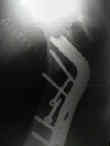
- Technique of Blade Plate Insertion
- Reduction Techniques:
- direct reduction:
- if lesser troch is still attached to proximal fragment, psoas becomes deforming force causing flexion and external rotation of proximal fragment;
- 90 to 90 position aligns distal fragment;
- abduction of distal fragment may be needed to compensate for hip abductor force on the proximal frag;
- determine if fracture fragments are amenable to lag screw fixation prior to plate application;
- this may convert a complex mult-part frx to a more simple 2 or 3 part frx;
- indirect reduction:
- 95 deg blade plate is introduced into proximal fragment;
- either using the fracture table or a universal femoral distractor, the fracture site is destracted, bringing the frx out to length and assisting w/ reduction of of comminuted fragments;
- the medial fragments are not keyed into position (inorder not to strip these fragments of their soft tissue fragments);
- Disatal Seating of Plate:
- once proximal fixation has been established, distal screws are inserted;
- note that it is essential that at least one screw be inserted above the frx site (in addition to the blade plate) prior to distal fixation, in order that the blade plate is not pulled out;
- the first 1-2 screw(s) should be placed using dynamic compression (creating a tension band effect);
- the remaining screws are placed in a static mode;
